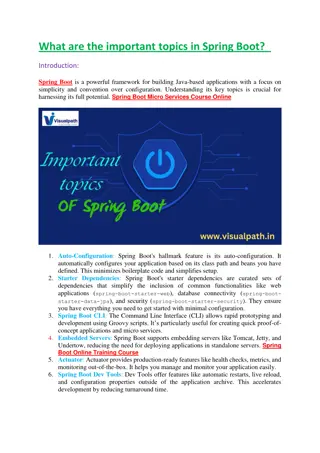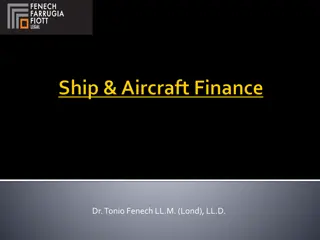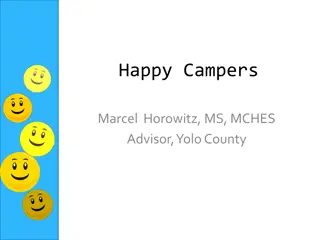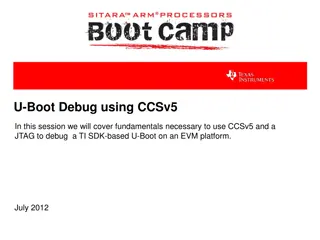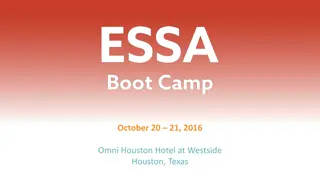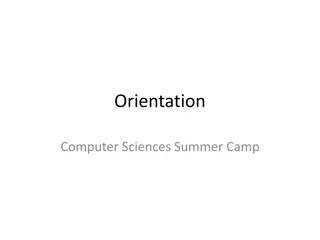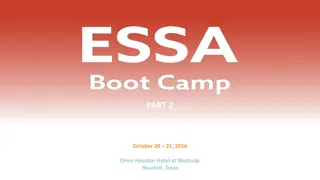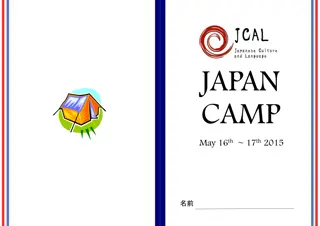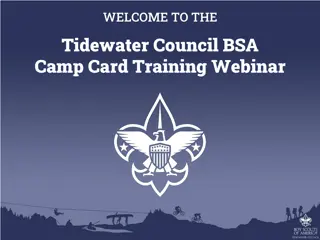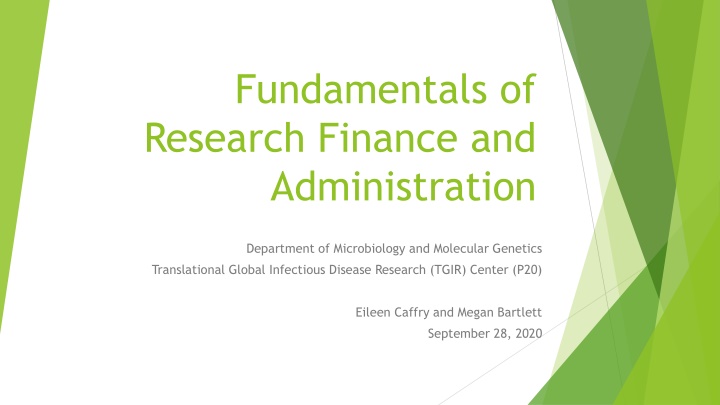
Award Financial Management in Microbiology - Roles and Responsibilities
Delve into the world of award financial management within the Microbiology and Molecular Genetics Department, exploring the responsibilities of Principal Investigators and Department Research Administrators. Discover the key aspects of handling sponsored awards, budget management, and post-award processes in this informative session.
Download Presentation

Please find below an Image/Link to download the presentation.
The content on the website is provided AS IS for your information and personal use only. It may not be sold, licensed, or shared on other websites without obtaining consent from the author. If you encounter any issues during the download, it is possible that the publisher has removed the file from their server.
You are allowed to download the files provided on this website for personal or commercial use, subject to the condition that they are used lawfully. All files are the property of their respective owners.
The content on the website is provided AS IS for your information and personal use only. It may not be sold, licensed, or shared on other websites without obtaining consent from the author.
E N D
Presentation Transcript
Fundamentals of Research Finance and Administration Department of Microbiology and Molecular Genetics Translational Global Infectious Disease Research (TGIR) Center (P20) Eileen Caffry and Megan Bartlett September 28, 2020
OVERVIEW Session Goals Principal Investigators and Department Research Administrators - Roles and Responsibilities Review the life cycle of a sponsored award expressed in terms related to budget and expenses: pre-award and post-award Communicating with your Department Research Administrators to successfully manage your award
FIRST A FEW BASICS Types of Financial Resources Available to PIs: restricted, unrestricted, designated, and start-up funds We ll focus on restricted funds from external sponsors, where spending is governed by terms and conditions of the sponsor. Examples: Federal grants and contracts Scientific, non-scientific, private foundations and associations Other Institutions (Subwards) Corporations/Industry Federal regulatory document, OMB A-21: Cost Principles for Educational Institutions and the Uniform Guidance contains legally binding regulations applicable to the use of federal funds. UVM generally applies these key criteria to federal and non-federal research awards. The cost must be allowable The cost must be allocable The expense must be reasonable, which means that the cost of acquiring the items or services should be in line with what a prudent person would pay.
ROLES & FISCAL RESPONSIBILITIES Principle Investigators Develops sponsored project proposals and corresponding budgets in compliance with sponsor and University guidelines Initiates advance account request, when appropriate Manages project budgets and approves expenditures Monitor's project expenditures to ensure all costs are allowable, reasonable, and allocable Seeks prior approval for budget changes when required Approves outgoing subawards documents and related invoices Department Research Administrators (aka Business Unit Administrators) Works closely with PIs on an individual basis and acts as liaison between PI and SPA on all of the above! Other administrative duties and assists PIs with salary distributions, requisitions, pur-card allocations, expense reports, journal entries, budget checking, chartstring changes, closeout reports
Life Cycle of Award Financial Management of an Award Close Out Award Understand Funding Opportunity Prepare Budget Accept Award Manage Award Post-award Pre-award
UNDERSTAND FUNDING ANNOUNCEMENTS Budget Criteria Sponsor Guidelines (Funding Opportunity or Program Announcements/RFPs) provide information concerning budget limitations, specific cost considerations, requirements for cost sharing, and other special financial information. Budget limit, salary caps, F&A cap, requirements for cost share, meeting attendance, and category constraints (limit xx category to xx%) Most funding opportunities will spell out allowable and unallowable costs. Reach out to department research administrator if unsure some can be subjective without a clear yes or no Failure to adhere to a Sponsor s budget or program guidelines may jeopardize funding for the proposal.
GETTING STARTED & BUDGET BUILDING Important to work with department research administrator once you decide to submit a funding application. In MMG, we require a minimum 4-week lead time, and sometimes more time is needed for complex awards or thosw including subaward In MMG, we use a specific departmental pre-award (intake) questionnaire to collect pertinent financial and other information Outgoing Subawards more complex, SPA needs specific info in advance of due date (Subrecipient Commitment form) Importance of Timing !! FIX THIS! Non-federal awards here s where I ll include your point: sometimes there is a fair amount of informal back and forth but which can result in budget changes/request for budget changes. (Here I ll say how the PI should navigate this. i.e. timing of routing and communication back to SPA on budget changes before agreement is received/signed)
BUDGET COMPONENTS Direct vs Indirect Costs Direct Costs Those budget line items that support performing the scope of work and are reasonable, easily identifiable and allocatable to the project. Personnel costs are the largest budget item (often about 80% of total directs) and expressed as percent effort, often using person month metric. The Principal Investigator is responsible for spending the direct costs on allowable costs such as: Personnel salaries/wages and associated fringe benefits, or stipends Non-personnel costs (aka Operating expenses or Other Directs) such as: Lab supplies and consumable materials Travel Equipment Core Facilities fees Subaward Direct Costs Tuition and Fees
BUDGET COMPONENTS Direct vs Indirect Costs Indirect Costs - Facilities and Administrative Costs (F&A) F&A costs are intended to recover the cost of sponsored project administration, department and college research administration, research compliance, purchasing, accounting, libraries, custodial services, building depreciation, and utilities. They are budgeted and collected as a percentage of the direct costs. Some direct costs are excluded from F&A (e.g., tuition and fees, equipment >$5,000, patients care costs, and subaward indirects in excess of $25,000).
OTHER BUDGET CONSIDERATIONS Cost Sharing Cost sharing occurs when UVM contributes quantifiable resources to a sponsored project beyond the amount funded by the sponsor. Different types. Most often cost share is in the form of salary caps Must be discussed and approved by Department Chair in advance Costs that Often Get Overlooked Shipping, dry ice, CO2, liquid nitrogen, equipment maintenance, computers Budget Escalation Factors In general, a 3% inflation factor recommended by SPA
PRE-AWARD LAST STEPS Just-in-Time and Other Support (federal awards) Just-in-Time refers to information requests after an application has been peer reviewed and is within a range of possible funding. Includes up-to-date Other Support, IACUC, IRB, and Human Subjects Education Documentation Other Support (current and pending) Go through department Research Administrator!! Requesting other support from your key personnel costs/effort can be out of date Include annual direct costs NOT total costs Include awards in no-cost extension
AWARD ACCEPTANCE Congratulations, you ve received an award agreement! It s important to review the award agreement for sponsor-specific or award-specific terms and conditions that can impact allowable spending. NIH grants and many other NIH funding sources will primarily point to the NIH Grants Policy and the federal OMB Uniform Guidance. These are the standard terms that must be followed and can be referenced when there are any questions about what is allowable or not. Specific items we want you to review: Confirm statement of work Research terms and conditions Specific items the department research administrator wants you to take note of, or be aware of that we will discuss with you: Confirm award dollar amounts If carryover is allowed, automatic, and/or what s required to request it. Rebudgeting allowances How and what amount you are allowed to rebudget between budget categories. UVM and NIH policy is 25% of the total award, but some sponsors may be stricter than this. Budget categories as they are defined by the sponsor may differ from UVM s. Prior Approval requirements: Reviewing what changes require prior approval
Post Award Financial Management - Spending Money At UVM there is a process for getting an award setup to be able to start charging expenses to the project. At times, this can be lengthy depending on factors such as unique terms and conditions, response times in getting a fully executed agreement, and the overall queue in SPA The department research administrator will typically coordinate with SPA and follow-up regularly to ensure this is done in a timely manner. The start date of an award is not necessarily when you receive it, but rather the specific date indicated on the award agreement. This is often retroactive to when we receive the award agreement. You are allowed to have expenses, as long as they are appropriate (for the conduct of the proposed research) that go back to the start date. Some sponsors also allow you to request spending prior to the start date. This is fairly rare and so you should discuss this with your department research administrator if you think you will want to pursue this. If an award is taking an exceptionally long time to be setup, we may request from SPA an Advance Account which just requests the setup of a chartstring prior to having a fully executed agreement. As you begin spending on your award, communicate with your department research administrator to obtain your project chartstring or discuss interim plans.
Post Award Financial Management UVM Chartstrings Once your award is setup in the UVM Peoplesoft Financial system, you will receive a chartstring. Your project chartstring is the unique combination of values that allocates expenses to your project within our Peoplesoft system. Name AccountOperating Dept Fund Source FunctionPC Bus Project Activity Program Purpose Property Unit 2 Unit 5 Length (no. of digits) 5 5 3 6 3 6 4 4 4 4 xxxxx xx xxxxx xxx xxxxxx xxx XXXXX xxxxxx XXXX xxxx xxxx xxxx Allocating expenses to the appropriate chartstring is the only way to tie expenses to your project and obtain payment from the sponsor. This will be primarily handled by your department research administrator, business manager, or business support staff. It very important that you take note of the chartstring and manage it accordingly. There are many internal charges that request a chartstring from the investigator or technician. It is vital that you review and confirm that these are correct on a regular basis. It is ultimately your responsibility to ensure that charges post to the correct project. Some examples are: iLabs with the many core facilities, biostockroom, VACC, bookstore, shipping Specifically notify your department administrator if you will be shipping samples or materials. It is significantly cheaper to use the UVM Fedex account but requires some additional setup. For some awards, this unique chartstring will change year to year and it is very important that you pay attention to this and adjust your records accordingly.
Getting The Most Out of Budget Reviews Regular budget reviews with your department research administrator are key to understanding the financial status of your award and ensure you are in compliance when signing off that all expenses are appropriate. It is also valuable to planning for future directions and forecasting. Your department should have a process in place for doing these reviews. However, if you aren t getting what you need or need an ad hoc review, don t hesitate to reach out and ask. Depending on your department, and your research portfolio, how this is executed may vary These reviews should happen at least quarterly if not more frequently. At these meetings, the research administrator will review where the project is at financially Review percent effort for all personnel on the grant What are known upcoming expenses (encumbrances) and planned expenses (forecasted) Are there any changes to the proposed budget which require prior approval or administrative setup Reviewing itemized operating for appropriateness and look for: Expenses that appear to be missing Expenses that were meant for another project Internal charges whose reference chartstrings weren t updated This is your opportunity to review in a timely manner, and ensure that all expenses are allowable, reasonable, and allocable to the project to the work proposed and performed. This is a key responsibility of the PI. If an expense is not appropriate for that project, and if we don t identify it within 90 days of the transaction date, this may come out of your individual funds
Reviewing Progress and A Post Award Resource As you are involved in the research on a daily basis, you should be aware of any delays in the progress of a given project. Communicate with your department research administrator when there are delays and identify any changes that need to be made (effort or planned purchases) and/or at least have a justification to explain any differences. Department research administrators don t often know where your research is at scientifically as time progresses so it s up to you to communicate along the way. It s not about always knowing what to say or tell, but reaching out with questions or comments and giving us a chance to ask questions and clarify. This includes regular communication with your subaward (if applicable) to make sure you are aligned in your progress and expectations. The most important takeaway is to not reach the end of the project year or award, with these two variables out of alignment or corrections identified. It is so vital that you work with your department research administrator at regular intervals, to identify errors, corrections, or adjustments. PI PORTAL In addition to regular budget reviews, there is also a tool in the UVM Peoplesoft Financials where you can look up the financial status of a given project. Pros: This is updated nightly, you can see budget, expenses, and remaining dollars by budget category. You can see payroll breakdown, itemized transaction detail, and any financial reports/invoices that were submitted by SPA. Cons: This won t include any pending charges or changes. For example, purchases on a purcard that have not been reallocated or personnel changes. It also won t include any planned expenses, further forecasting, or calculation of carryover.
Unobligated Balances Unobligated balances; also known as carryover, carryforward, remaining balance, or unspent funds It s very important to work with your department research administrator to monitor what percent of the total award this is at, or is forecasted to be at the end of the award period. This is important both at the end of each project year and at the end of the award itself. Depending on what the award agreement says about carryover, it may rollover automatically, or it may require a formal request and separate budget. NIH policy is that more than a 25% carryover requires additional justification even if it is indicated as automatic carryover. Carryover is meant to be spent in the next project year and not carried over year to year. This can be difficult if it is fairly large, but it is something to watch and make strategic plans to address. These funds will be viewed differently depending on the sponsor. Again, some are stricter than others so it is important to review the award s terms and conditions. No Cost Extension If you have funds remaining at the end of the award period, this is likely because work was delayed in some way and so you also need additional time to complete the proposed work. Requesting additional time to complete the work and spend remaining funds (but not additional funds) is called a no cost extension. Each sponsor will handle this differently, ranging from a simple email, a formal request, or simply an update to the end date in a online system (NIH). And in some rare cases, it s simply not allowed. If a No Cost Extension will be requested, this needs to be decided prior to the award end date. At least 30 days, preferably 90 days before the award end date. This allows the research department administrator to communicate with SPA, process the approved extension, and ensure that the project chartstring remains active.
Award Closeout There are annual closeouts and final closeouts both resulting in a financial report and final invoice sent by SPA to the sponsor. They are both very similar in that SPA will look at the terms and conditions, what was budgeted, and what was expensed, and effort charged to make sure everything lines up. If not, they will reach out to the research department administrators with clarifications. And we very well may reach out to the PI to confirm. Depending on the due date for the financial report, there may be a short turn around to finalize all expenses on a project. Once this is finalized and a project is closed out, there can be no more changes, no further expenses charged. If you are actively participating in regular reviews than this should not be an issue and all final expenses would already be posted by the award end date, approximately. There are a few lingering expenses such as purcard expenses, or internal charges. These can sometimes be delayed, but this is allowable as long as the expense was incurred and utilized before the end date. SPA will question any expenses incurred within the last 90 days to ensure that they are appropriate and allowable. At the department level, we recognize that work may continue right up to the end of an award, so it s reasonable that there will be expenses, but we will have to justify or confirm their appropriateness. This is where we must affirm to SPA that all expenses are allowable, reasonable, and allocable to the project to the work proposed and performed. Making changes (moving expenses) at the end of an award especially, can raise red flags and that an award hasn t been properly managed and will raise questions about the appropriateness of all other expenses. The financial report is just one piece of the closeout report, but it can take a fair amount of research administrator time, and puts the final bow on the financial picture of your award. Generally once an award is closed, there will be no further review at the department level on an ongoing basis. But looking back at previous awards, can be helpful with budgeting or forecasting on future projects.
Next Steps Upcoming Research Administration Bootcamps Research Compliance Our second boot camp will focus on various aspects of research compliance. In addition to reviewing your responsibilities on regulatory compliance, there are also very important financial and contracting compliance requirements that do involve either attention or deliverables from the PI. The goal of this training is to introduce you to what you should be aware of and help you to understand what and when to ask your department research administrators. Geared towards new, early stage and seasoned investigators alike, you should come away feeling more confident navigating research compliance matters involving PIs. A glossary of terms and useful links will be provided. Life Cycle of an Award PI Perspective When a PI is thinking about a research grant, it can be easy to oversimplify it into writing the proposal and then doing the work. While that should be your primary focus, there are additional steps or segments that you must at least be aware of, if not also participate in assembling. We will go over the life cycle of an award, from identifying the funding opportunity to closing out the award, from the perspective of the PI, providing helpful tools and resources for completing each step and the timelines associated with each. You should leave this training with a strong understanding of the big picture structure and timelines to help you win your next award. Geared towards new, early stage and seasoned investigators alike, you should come away feeling more confident in your understanding of the life cycle of an award. A glossary of terms and useful links will be provided.
USEFUL LINKS & RESOURCES MMG Resources: https://www.med.uvm.edu/mmg/department_resources UVM SPA Links PI Responsibilities: https://www.uvm.edu/spa/roles-and-responsibilities-principal-investigator PeopleSoft PI Portal: https://www.uvm.edu/spa/pi-portal SPA Presentation Decks (Classes): https://www.uvm.edu/spa/education-and-learning Subawards: https://www.uvm.edu/spa/outgoing-subawards Budget development: https://www.uvm.edu/spa/develop-budget SPA Fact Sheet: https://www.uvm.edu/spa/spa-fact-sheet Financial conflicts of interest: https://www.uvm.edu/ovpr/research-integrity-financial-conflict-interest-sponsored-research NIH Application Guide: https://grants.nih.gov/grants/how-to-apply-application-guide.html NIH Pre- and Post-Award Processes: https://grants.nih.gov/grants/pre-and-post-award-processes.htm NIH guide to understanding indirect costs: https://www.niaid.nih.gov/grants-contracts/understanding-indirect-costs NIH Grants Policy Statement definition of terms: https://grants.nih.gov/grants/policy/nihgps/html5/section_1/1.2_definition_of_terms.htm NSF online grants management: https://www.research.gov/research-web/ Other Support Documents: FAQs on Other Support

